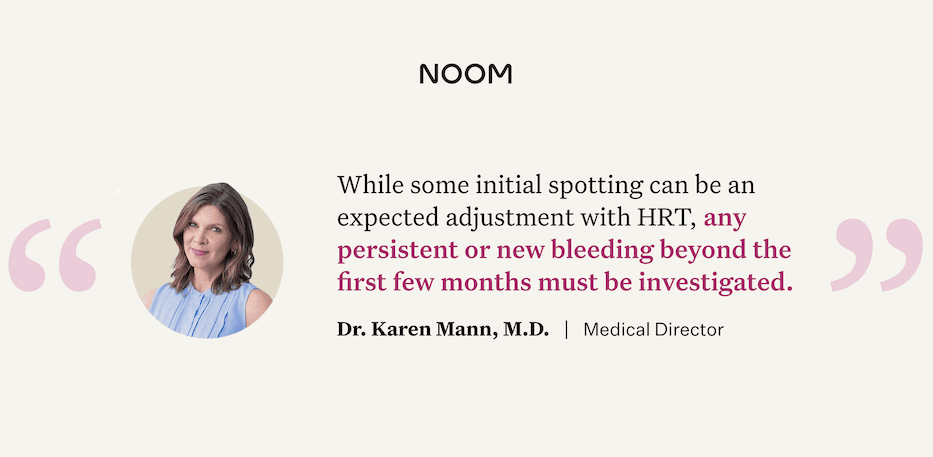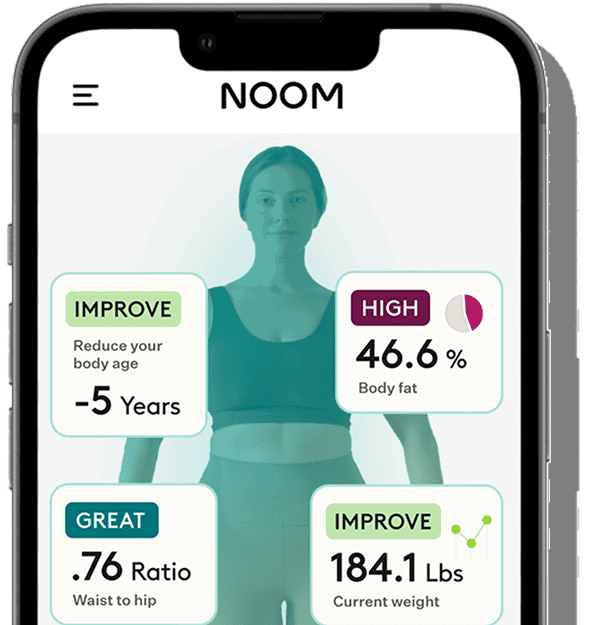What you’ll learn:
- Bleeding after menopause is always something your doctor should check out.
- While up to 90% are caused by benign conditions, postmenopausal bleeding is the most common sign of endometrial cancer.
- Other possible causes include vaginal or uterine thinning (atrophy), fibroids, polyps, HRT, or certain medications.
Menopause literally marks the end of your menstrual cycle, and that means that monthly bleeding stops. Technically, once you’ve gone 12 months without a menstrual cycle, you’ve reached menopause. For most women in the U.S., that happens around age 51.
So what if you notice bleeding or spotting after that?
Any vaginal bleeding after menopause—whether it’s just a few spots or a full flow—should be brought up with your doctor. That might sound alarming, but try not to panic. In about 90% of cases, the cause is something benign.
Still, bleeding after menopause is your body’s way of saying something’s up.
In this guide, we’ll walk you through what might be going on, how to talk to your provider, and what to expect at your appointment. You’ll also find answers to common questions, tips for preventing some of the typical causes, and when medication (or HRT) might help.
Understanding bleeding after menopause
Postmenopausal bleeding refers to any vaginal bleeding that occurs a year or more after your last period. That’s different from the irregular bleeding that can happen during perimenopause—the transition phase leading up to menopause—when your cycle might be all over the place.
What does bleeding after menopause look like?
Postmenopausal bleeding doesn’t always look the same for everyone—it can show up in a few different ways. You should watch for any of the following:
- Light spotting or seeing a small amount of blood on toilet paper after using the bathroom
- Pink, red, or brown vaginal discharge
- A flow that seems to mimic a menstrual period, which can be light or heavy
- Passing blood clots
- Bleeding that occurs specifically after vaginal intercourse
Why is bleeding after menopause a concern?
Here’s where things can get confusing: Postmenopausal bleeding is most often caused by non-cancerous conditions like vaginal or uterine lining thinning, known as atrophy. But it’s also the most common early warning sign of endometrial cancer.
That’s why it’s so important to check in with your doctor. While the chances are high that it’s something benign, ignoring the symptom could mean missing the opportunity to catch something more serious early.
To put the research in perspective:
- Over 90% of people diagnosed with endometrial cancer report that their first symptom was postmenopausal bleeding.
- At the same time, less than 10% of people who see a doctor for postmenopausal bleeding are ultimately diagnosed with uterine cancer.
Don’t assume the worst, but don’t dismiss it either. There’s no way to tell the cause of postmenopausal bleeding without a proper medical evaluation. Seeing your provider is the only way to get answers.
When is postmenopausal bleeding most common?
About 10% of people will experience bleeding after menopause. It’s also one of the most frequent reasons people go to see their OB-GYN after menopause.

Bleeding tends to be more common in the first year after menopause, but can be more concerning the further you are from menopause. The risk of endometrial cancer increases with age, which makes bleeding that occurs 5, 10, or even 20 years after your last period a red flag that needs to be checked out promptly by your healthcare provider.
“While it’s a common concern, any bleeding after menopause truly warrants a prompt evaluation to rule out serious conditions and provide peace of mind,” advises Dr. Karen Mann.
Postmenopausal bleeding: Causes and risk factors
The reasons for postmenopausal bleeding are varied, ranging from easily treatable issues to more complex conditions. Let’s go through the most common and concerning ones.
The most common causes of bleeding after menopause
In up to 90% of cases, postmenopausal bleeding is caused by a benign condition, such as atrophy, endometrial polyps, or fibroids, which we’ll talk about. These are often easily managed and, while they warrant evaluation, aren’t generally a cause for alarm. Here’s a look at what your doctor will check for:
- Thinning vaginal and uterine tissues: Vaginal and endometrial atrophy are the top reasons for post-menopausal bleeding, causing up to 60% of cases. After menopause, falling estrogen levels make these tissues thinner, drier, and more fragile, prone to tearing and bleeding. This tissue change is one feature of the genitourinary syndrome of menopause (GSM)—a term that also covers vaginal-dryness, pain with sex, and urinary symptoms such as urgency or recurrent infections.
- Uterine polyps: These are typically non-cancerous growths that attach to the inner wall of the uterus. They are quite common after menopause and can cause unpredictable spotting or bleeding. Although most polyps are benign, a very small percentage can contain cancerous or precancerous cells, which is why doctors usually recommend removing and testing them.
- Uterine fibroids: Fibroids are non-cancerous tumors that grow in the muscular wall of the uterus. They are fueled by estrogen, so they typically shrink and stop causing problems after menopause. In some cases, particularly in individuals with a higher body weight, the body continues to produce enough estrogen in fat cells to sustain fibroids, which can then lead to bleeding.
- Hormone replacement therapy (HRT): Studies show that in the first six months of use—or when doses change—some forms of HRT can cause bleeding as the body adjusts.
- Medication side effects: Some medications are known to trigger postmenopausal bleeding. These include blood thinners (anticoagulants) and tamoxifen. If you’re taking any of these and notice unexpected bleeding, it’s important to speak with your healthcare provider to rule out other causes.
Pre-cancerous and cancerous conditions
While less common, it’s the possibility of more serious conditions that makes a doctor’s visit so essential.
- Endometrial hyperplasia: This thickening of the uterine lining (endometrium) is considered precancerous. It develops due to a hormonal imbalance, specifically, too much estrogen without enough progesterone to balance it out. This “unopposed estrogen” signals the endometrium to keep growing instead of shedding monthly as it did before menopause. Doctors classify hyperplasia into two main types:
- Hyperplasia without atypia: These abnormal but normal-looking cells are at a low cancer risk.
- Atypical hyperplasia: These abnormal-looking cells have a higher risk of progressing to cancer if left untreated.
- Endometrial cancer (uterine cancer): This begins in the endometrium and is the most common cancer of the female reproductive organs in the United States. As mentioned, abnormal bleeding is the first symptom in over 90% of cases. Because it announces itself with this early warning sign, it is often caught at an early stage. When endometrial cancer is discovered before it has spread, the 5-year survival rate is an encouraging 95%.
- Other cancers: In rare instances, bleeding after menopause can be a symptom of vaginal, cervical or ovarian cancer.
“The excellent prognosis for endometrial cancer, when caught early, underscores why prompt evaluation is truly vital,” explains Dr. Mann.
Bleeding after menopause: Risk factors
While postmenopausal bleeding can have many possible causes, certain health conditions, medications, and other factors may raise the likelihood of it occurring. Here’s a look at what makes it more likely and when it might happen.
- Time since menopause: Bleeding is more common within the first year after menopause and becomes less frequent over time. One study found it occurs in about 40% of people within one year, but only 4% after three years.
- Thickened endometrial lining: If the lining of the uterus looks thicker than expected on an ultrasound, it may be more likely to bleed. A thickened endometrium can raise the risk of endometrial cancer in people who are already experiencing postmenopausal bleeding.
- Fibroids and polyps: Benign growths like uterine fibroids and endometrial polyps are common causes of postmenopausal bleeding, especially in those with a history of these conditions.
- HRT and medications: Estrogen-only HRT, tamoxifen, and anticoagulants (like warfarin) can all increase the risk of bleeding after menopause.
- High BMI, diabetes, and hypertension: These conditions are associated with hormonal imbalances and a higher risk of endometrial hyperplasia or cancer, which may present as postmenopausal bleeding.
When to see a doctor for bleeding after menopause (and what to expect)
Again, if you experience any bleeding after menopause, schedule an appointment with your healthcare provider or a gynecologist. If it comes with heavy bleeding, pain, fever, problems urinating, dizziness, or fatigue, you should go to an emergency room for immediate evaluation.
To make your visit as productive as possible, it helps to come prepared. Before your appointment, try to jot down a few notes about:
- The bleeding itself: When did it start? How often does it happen? Is it spotting or a heavier flow? What color is it?
- Any associated symptoms: Have you had any pelvic pain, cramping, fever, or unusual discharge?
- Your current medications: Make a list of everything you take, including prescriptions, HRT, over-the-counter drugs, vitamins, and herbal supplements.
- Your health history: Be ready to discuss your personal and family medical history, including any of the risk factors mentioned earlier.
Common tests used to diagnose the cause of bleeding after menopause
Your doctor’s primary goal is to rule out the most serious causes, particularly endometrial cancer. The process unfolds in steps, where the results of one test determine if the next, more involved test is needed.
- Pelvic exam: The evaluation almost always begins with a physical and pelvic exam to check for any obvious abnormalities, tenderness, or masses.
- Transvaginal ultrasound: This initial imaging test visualizes the uterus and ovaries and measures uterine lining thickness to determine cancer risk.
- Endometrial biopsy: If the ultrasound shows a thickened lining or other risk factors, a biopsy is typically next. A small tissue sample from the uterine lining is collected in the office and examined for hyperplasia (cell changes) or signs of cancer.
- Hysteroscopy and D&C: For some, a hysteroscopy involves inserting a tiny camera to directly view the uterine lining, locate bleeding, and take targeted biopsies or remove polyps. This is often combined with a dilation and curettage (D&C), where the cervix is gently opened to collect tissue from the lining for diagnosis or treatment.
Medical treatments for postmenopausal bleeding
Once a diagnosis is made, your healthcare provider will recommend a treatment plan tailored specifically to the cause of your bleeding. Again, most causes are treatable.
Treating benign conditions
- For thinning and drying of the tissues: When bleeding is due to genitourinary syndrome of menopause (GSM), treatment aims to restore moisture and tissue health.
- Non-hormonal options: Over-the-counter vaginal moisturizers and lubricants (used during intercourse) can provide significant relief.
- Hormonal options: The most effective treatment is typically low-dose, topical estrogen. This comes in the form of creams, vaginal rings, or tablets that are placed in the vagina. This approach is highly effective because it delivers estrogen right where it’s needed and very little is absorbed into the rest of the body, minimizing systemic risks.
- For polyps and fibroids:
- If polyps are causing bleeding, standard treatment is surgical removal. This stops the bleeding and provides a tissue sample to be tested for any abnormalities.
- Fibroids often don’t require treatment after menopause if they are not causing symptoms. If they are, they can be managed with medication or removed surgically.
Treating a thickened uterine lining during postmenopausal bleeding
Treatment for a thickened uterine lining depends entirely on whether “atypical” cells are present.
- For hyperplasia without atypia: Treatment focuses on helping the thickened uterine lining return to normal using the hormone progestin. Progestin can be taken as a pill, an injection, or through an IUD that releases the hormone directly into the uterus.
- For atypical hyperplasia: These abnormal cells have a higher risk of turning into cancer. A hysterectomy (surgical removal of the uterus) is often the recommended treatment to eliminate the risk.
Does HRT cause bleeding?
HRT can cause bleeding—especially in the first few months—as the body adjusts to new hormone levels. Studies show that up to 40% of people on continuous combined HRT experience breakthrough bleeding in the first 3 to 6 months, which often improves over time. Bleeding patterns can also vary depending on the type and delivery method of HRT used.

Here’s a look at what matters:
- How it’s administered: Oral HRT tends to result in less breakthrough bleeding than transdermal patches, and bleeding diminishes with time, according to research.
- The type of HRT: The kind of progestin used also makes a difference—natural progesterone is linked to fewer bleeding issues than synthetic versions like medroxyprogesterone or drospirenone.
Cyclic vs. continuous use: Cyclic HRT regimens, which include scheduled breaks in progestin use, are more likely to cause monthly bleeding. Continuous combined regimens tend to reduce bleeding over time.
HRT is considered the most effective treatment for several moderate to severe menopause-related symptoms, especially those caused by low estrogen. This includes hot flashes, night sweats, vaginal dryness, sleep disruptions related to night sweats, mood swings, and the prevention of bone loss.
If you’re taking HRT and experience unexpected bleeding after the first few months, it should be evaluated just like any other case of postmenopausal bleeding to rule out underlying causes.
“While some initial spotting can be an expected adjustment with HRT, any persistent or new bleeding beyond the first few months must be investigated,” says Dr. Mann.
Lifestyle adjustments and natural approaches to improve health after menopause
While you can’t always prevent postmenopausal bleeding, there are things you can do to support hormonal health and reduce the chances of abnormal bleeding.
The most effective natural strategies are lifestyle changes that improve your overall health.
- Maintain a healthy weight: Being at a healthy weight can lower your risk of cancer, including endometrial cancer. After menopause, excess body fat can influence the body’s hormone levels, potentially contributing to elevated estrogen..
- Eat a nutrient-dense diet: What you eat plays a huge role in weight management and overall health. A menopause-friendly diet focuses on nutrient-dense foods that keep you full and energized.
- Prioritize protein: Aim for lean protein sources like chicken, fish, beans, and tofu at every meal. Protein helps maintain muscle mass, which declines with age, and keeps your metabolism running efficiently.
- Fill up on fiber: Load your plate with fruits, vegetables, and whole grains. These foods are high in fiber, which helps you feel full.
- Get essential nutrients: Ensure you’re getting enough calcium and vitamin D for bone health, which is critical after menopause.
- The benefits of movement: Regular physical activity is crucial after menopause. Research shows that exercise helps preserve bone density, muscle strength, and heart health, all of which decline as estrogen levels drop. A well-rounded routine that includes aerobic activity, strength training, and balance or flexibility work can also support weight management, improve mood, and reduce fall risk.
- Managing stress and sleep: Chronic stress elevates cortisol, which can trigger cravings and encourage fat storage. Similarly, poor sleep disrupts hunger and fullness hormones, making weight management challenging. Noom’s psychology-based lessons offer techniques like mindfulness and cognitive reframing to help you manage stress, reduce emotional eating, and improve overall well-being.
Can supplements treat or prevent bleeding after menopause?
There isn’t high-quality evidence that herbal supplements can treat the underlying causes, such as hormone imbalances or changes in the uterine lining.
- Black cohosh: While some studies suggest it may help relieve hot flashes, it has not been shown to affect postmenopausal bleeding, and in rare cases, it may actually cause it.
- Phytoestrogens (red clover, soy, flaxseed): These plant compounds act like weak estrogens in the body. Studies on their effectiveness for menopause symptoms are inconsistent, and their long-term safety—especially for people with hormone-sensitive conditions—hasn’t been established.
- Other herbs (dong quai, wild yam, ginseng): These are sometimes marketed for “hormone balance,” but there isn’t enough solid research to recommend them for managing postmenopausal bleeding. Some, like dong quai, may even increase bleeding risk due to anticoagulant effects.
“When facing postmenopausal bleeding, it’s important to prioritize evidence-based medical evaluation and proven lifestyle strategies over unverified natural remedies,” says Dr. Mann.
Frequently asked questions about bleeding after menopause
Why am I bleeding after 10 years of menopause?
There’s no way of knowing without an examination from a doctor. Any bleeding that occurs years after menopause should be evaluated as soon as possible.
What is the most common reason for bleeding after menopause?
The most common cause of postmenopausal bleeding is atrophy—the thinning, drying, and inflammation of the tissues lining the vagina and uterus due to low estrogen levels. This benign condition accounts for up to 60% of all cases.
Is bleeding after menopause always cancer?
No, absolutely not. In fact, about 90% of the time, postmenopausal bleeding is caused by non-cancerous (benign) conditions like atrophy or uterine polyps. But, because it is the most common symptom of endometrial cancer, it must always be evaluated by a doctor to rule out a serious condition and ensure you get the correct diagnosis and treatment.
Can fibroids cause bleeding after menopause?
Yes—although fibroids typically shrink after menopause, they can still cause bleeding if they don’t regress or if new growths develop. Rarely, postmenopausal bleeding may signal a degenerating or calcified fibroid.
Can blood thinners cause menstrual bleeding after menopause?
Yes—blood thinners like warfarin or aspirin can make postmenopausal bleeding more likely by reducing the blood’s ability to clot, especially if there’s an underlying uterine condition.
Can a yeast infection cause bleeding after menopause?
Yeast infections don’t usually cause bleeding, but the irritation or inflammation they trigger—especially in thinner, postmenopausal vaginal tissue—can lead to light spotting.
Can stress cause bleeding after menopause?
Stress alone isn’t a direct cause of postmenopausal bleeding, but it may worsen underlying hormonal imbalances or disrupt other systems that contribute to abnormal bleeding.
The botton line: Managing bleeding after menopause with Noom
Postmenopausal bleeding can be concerning, especially if it happens years after your last period. But in most cases, it’s caused by something benign and treatable, like thinning tissues, polyps, or fibroids. Most people who see a doctor for postmenopausal bleeding aren’t diagnosed with cancer. Still, because it can signal something more serious, it’s important to get it checked out.
A visit with your provider—usually starting with a pelvic exam and ultrasound—can help identify the cause and guide next steps. Most common causes of postmenopausal bleeding can be managed with medication, hormone therapy, minor procedures, or lifestyle adjustments. Don’t try to figure it out on your own. Knowing what’s normal for your body—and when something changes—helps you stay informed and proactive.
If you’re looking for structured support through this phase of life, Noom + HRTRx offers personalized guidance for managing menopause symptoms, including HRT when appropriate. Our science-backed approach pairs expert care with behavior change tools to help you feel more in control—whether you’re dealing with bleeding, weight shifts, sleep changes, or just trying to feel like yourself again.




 Noom Team
Noom Team
 Shoshana Fishbein
Shoshana Fishbein

